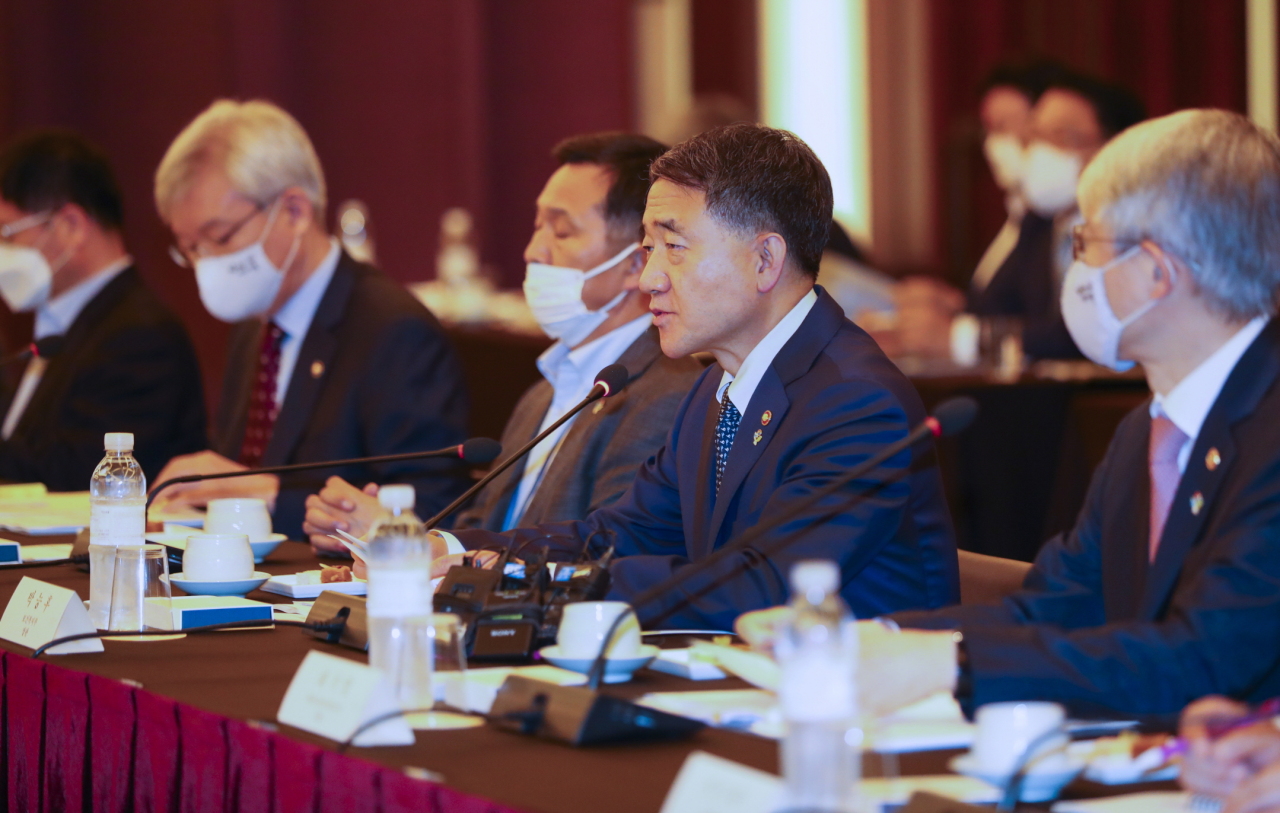Health chief vows to deliver coronavirus vaccine
‘Almost all recent COVID-19 patients concentrated in Seoul area’
By Kim ArinPublished : June 3, 2020 - 10:20

South Korea’s top health official said Wednesday cures and vaccines for the novel coronavirus causing COVID-19 “need to be secured at all costs,” vowing an all-out endeavor to deliver a domestically made vaccine by next year.
Minister of Health and Welfare Park Nueng-hoo said in a third meeting of the committee for developing coronavirus drugs and vaccines that the government would “see to have them produced -- as fast as possible, if not the world’s first.”
Park said the government has set aside over 100 billion won ($82 million) for the latter half of this year to fund the clinical trials, explaining, “The pandemic is expected to last a long time, which makes getting a vaccine even more of an essential aim.”
Health authorities have said Korea’s exit from the pandemic will not be complete without a vaccine or a treatment.
Seasoned infectious disease expert Dr. Kim Woo-joo of Korea University Hospital in Guro, southern Seoul, said in a phone interview that investing in vaccine development was “our best bet on a way out.”
“Interventions such as physical distancing help slow the spread and keep the number of cases within a manageable range, but they cannot be the ultimate solutions,” he said, adding that coronavirus drugs and vaccines were “the most needed medical breakthroughs right now to vanquish the viral foe.”
Pulmonologist Dr. Jung Ki-suck, who helmed the Korea Centers for Disease Control and Prevention in 2016-2017, said the government-proposed timeline of having a Korea-made vaccine by next year “would not be feasible under a normal time frame” and that “all the usual protocols will have to be skipped over.”
“If everything goes smoothly, we might have something like vaccine prototypes by early next year,” he said.
He also warned of the dangers of rushing a vaccine without properly ensuring they are safe as well as effective.
“Vaccines must be rigorously tested before they are authorized for widespread use,” he said.
Following relaxation of controls in early May, the virus flared back up again, mainly in the greater Seoul area, recording 49 new cases Wednesday.
The Health Ministry’s second-in-command Kim Gang-lip said in a press briefing Wednesday morning that, “Almost all of the recently confirmed patients are in and around Seoul.”
Over 90 percent of Wednesday’s tally, or 45 cases, were found in Seoul and adjacent cities. Three were recent travelers from abroad who tested positive after passing through airport checkpoints, and one was in Daegu.
In the past four weeks, the patient count in the metropolitan region -- which includes Seoul, Gyeonggi Province and Incheon -- rose by over 600 from 1,418 on May 8 to 2,023 as of Wednesday.
Risky venues such as bars, nightclubs and karaoke lounges, large workplaces, private cram schools and churches were among sites of active outbreaks identified lately, health officials said.
The coronavirus rebound has led to a steep rise in the number of people placed under home quarantine. As of 6 p.m. Tuesday, 39,944 were in quarantine, which is an increase of 1,100 from the same time the previous day, the Ministry of Interior and Safety said. Of them, 29,613 are linked to overseas travels and 10,331 to local transmissions.
At least 498 quarantined individuals have broken the orders so far, with 329 having undergone police investigations and 206 referred to the prosecution, according to ministry data.
Amid the phased opening of in-person classes, KCDC’s Director Jung Eun-kyeong told reporters Wednesday that another suspected case of mysterious children’s disease with potential ties to COVID-19 has been discovered, marking a third such case here to date.
Jung said two earlier cases -- a 11-year-old boy and a 4-year-old girl -- showing symptoms of the pediatric condition now known as multisystem inflammatory syndrome in children were in fact Kawasaki disease. Both tested negative for the novel coronavirus.
In May, the disease control agency tested 48,889 school-age children to find 70 of them -- 0.14 percent -- had contracted the disease.
To prevent a possible spread in schools, students, family members of students and teachers were urged stricter compliance to social distancing, the KCDC director said.
“Everyone has to do his or her part to stem the coronavirus,” said Kim of the Health Ministry. “We should act as though we have the virus as we go about our daily routines, and reduce contact with others as much as we can.”
Korea’s cumulative count of COVID-19 cases stands at 11,590. Of them, 10,467 have recovered, with 860 now receiving treatment. There have been 273 deaths.
By Kim Arin (arin@heraldcorp.com)



![[AtoZ into Korean mind] Humor in Korea: Navigating the line between what's funny and not](http://res.heraldm.com/phpwas/restmb_idxmake.php?idx=644&simg=/content/image/2024/04/22/20240422050642_0.jpg&u=)
![[Exclusive] Korean military set to ban iPhones over 'security' concerns](http://res.heraldm.com/phpwas/restmb_idxmake.php?idx=644&simg=/content/image/2024/04/23/20240423050599_0.jpg&u=20240423183955)



![[Graphic News] 77% of young Koreans still financially dependent](http://res.heraldm.com/phpwas/restmb_idxmake.php?idx=644&simg=/content/image/2024/04/22/20240422050762_0.gif&u=)
![[Herald Interview] Why Toss invited hackers to penetrate its system](http://res.heraldm.com/phpwas/restmb_idxmake.php?idx=644&simg=/content/image/2024/04/22/20240422050569_0.jpg&u=20240422150649)






![[Exclusive] Korean military to ban iPhones over security issues](http://res.heraldm.com/phpwas/restmb_idxmake.php?idx=652&simg=/content/image/2024/04/23/20240423050599_0.jpg&u=20240423183955)



![[Today’s K-pop] Ateez confirms US tour details](http://res.heraldm.com/phpwas/restmb_idxmake.php?idx=642&simg=/content/image/2024/04/23/20240423050700_0.jpg&u=)